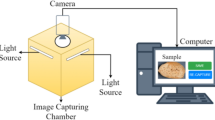Abstract
In recent years, the number of maize disease species has increased, which obviously increases the level of damages in leaves. The reason for maize leaf disease is due to variations in agriculture systems, the variants of pathogen, and it also occurs due to the scarcity of plant conservation measures. The disease in maize leaves can be exhibited by varied symptoms; however, it might be complex for farmers to identify the disease in naked eye. Therefore, this paper intends to present a new automatic system for identifying and diagnosing maize leaf diseases. The proposed model includes two major phases: Proposed Feature Extraction and Classification. The first phase is feature extraction, where the proposed 4D-Local Binary Pattern (4D-LBP) based texture features will be extracted. More particularly, Dimension 1 insists pixel intensity, dimension 2 insists angle, dimension 3 insists local frequency from intensity patch and dimension 4 insists global frequency as well. Once the features get extracted, they are subjected for classification process, where the optimized Convolutional Neural Network (CNN) is used, where the count of convolutional layers is optimally tuned. For this optimal selection, a new Adaptive Opposition based Spider Monkey optimization (AOSMO), which is the enhanced version of SMO algorithm. At last, the performance of proposed work is evaluated over other traditional models with respect to accuracy.










Similar content being viewed by others
Abbreviations
- LBP:
-
Local binary pattern
- CNN:
-
Convolutional neural network
- AOSMO:
-
Adaptive opposition based spider monkey optimization
- ANN:
-
Artificial NN
- SVM:
-
Support vector machine
- DAS-ELISA:
-
Double antibody sandwich-ELISA
- RTPCR:
-
Reverse transcriptase polymerase chain reaction
- RF:
-
Random forest
- MLP:
-
Multi-layer perceptron
- FFSS:
-
Fission fusion social structure
- LLP:
-
Local leader phase
- GLP:
-
Global leader phase
- GLL:
-
Global leader learning phase
- LLL:
-
Local leader learning phase
- LLD:
-
Local leader decision phase
- k-NN:
-
K-nearest neighbour
- GLD:
-
Global leader decision phase
- MCC:
-
Matthews correlation coefficient
- NPV:
-
Net present value
- FOR:
-
False omission rate
- TS:
-
Threat score
References
Ramar AP, Selvaraj A, Madakannu A, Annamalai M (2019) Maize leaf disease classification using deep convolutional neural networks. Neural Comput Appl, 1–9, 17 May 2019
Zhang X, Qiao Y, Meng F, Fan C, Zhang M (2018) Identification of maize leaf diseases using improved deep convolutional neural networks. IEEE Access 6:30370–30377
Enquhone A (2017) Maize leaf diseases recognition and classification based on imaging and machine learning techniques. Int J Innov Res Comput Commun Eng 5(12)
Pashupat V, Kamaljit K, Pannu PPS, Gurjit K, Harleen K (2019) Unraveling the metabolite signatures of maize genotypes showing differential response towards southern corn leaf blight by 1H-NMR and FTIR spectroscopy. Physiol Mol Plant Pathol 108
Fentahun M, Feyissa T, Abraham A, Hae RK (2017) Detection and characterization of Maize chlorotic mottle virus and Sugarcanemosaic virus associated with maize lethal necrosis disease in Ethiopia: an emerging threat to maize production in the region. Eur J Plant Pathol 149(4):1011–1017
Malusi S, Mbuyu S (2019) A computational procedure for the recognition and classification of maize leaf diseases out of healthy leaves using convolutional neural networks. AgriEngineering
Tillessen A, Menkhaus J, Joseph-Alexander V (2018) Development of specific PCR primers for diagnosis and quantitative detection of the fungal maize pathogen Kabatiella zeae. Eur J Plant Pathol 152(2):503–506
Inos D, Elhadi A, Onisimo M, Kwabena A, Elfatih MA-R, John O, Mhosisi M (2018) Testing the capability of spectral resolution of the new multispectral sensors on detecting the severity of grey leaf spot disease in maize crop. Geocarto Int 33(11):1223–1236
Ladejobi O, Salaudeen MT, Lava Kumar P, Menkir A, Gedil M (2018) Mapping of QTLs associated with recovery resistance to streak virus disease in maize. Ann Agric Sci 63(1):115–121
Paswel PM, Olaf E, Boddupalli P, Dan M, Yoseph B (2018) Maize lethal necrosis disease: evaluating agronomic and genetic control strategies for Ethiopia and Kenya. Agric Syst 162:220–228
Nisha S, Samir R, Nishchal KS, Ricarda ME (2017) Influence of feeding crimped kernel maize silage on the course of subclinical necrotic enteritis in a broiler disease model. Animal Nutr 3(4):392–398
Qin Y, Peter B-K, Mingliang X (2017) Quantitative disease resistance: dissection and adoption in maize. Mol Plant 10(3):402–413
Cueto-Ginzo A, Serrano L, Sin E, Rodríguez R, Achon MA (2016) Exogenous salicylic acid treatment delays initial infection and counteracts alterations induced by Maize dwarf mosaic virus in the maize proteome. Physiol Mol Plant Pathol 96:47–59
Zhi-Yong Z, Lin Y, Shu-Feng Z, Han-Guang W, Feng-Ling F (2011) Improvement of resistance to maize dwarf mosaic virus mediated by transgenic RNA interference. J Biotechnol 153(3–4):181–187
Lyimo HJF, Pratt RC, Mnyuku RSOW (2012) Composted cattle and poultry manures provide excellent fertility and improved management of gray leaf spot in maize. Field Crops Res 126:97–103
Li-yu SHI, Xin-hai LI, Zhuan-fang HAO, Chuan-xiao XIE, Guang-tang PAN (2007) Comparative QTL mapping of resistance to gray leaf spot in maize based on bioinformatics. Agric Sci China 6(12):1411–1419
Ram K, Usha M, Robin G, Arti B, Harit RC (2016) Effect of elevated temperature and carbon dioxide levels on maydis leaf blight disease tolerance attributes in maize. Agric Ecosyst Environ 231:98–104
Mubeen S, Rafique M, Munis MFH, Chaudhary HJ (2017) Study of southern corn leaf blight (SCLB) on maize genotypes and its effect on yield”. J Saudi Soc Agric Sci 16(3):210–217
Shao-qing WANG, Jia MA, Meng WANG, Xin-hua WANG, Chen JG (2019) Combined application of Trichoderma harzianum SH2303 and difenoconazole-propiconazolein controlling Southern corn leaf blight disease caused by Cochliobolus heterostrophus in maize. J Integr Agric 18(9):2063–2071
Janse van Rensburg B, Mc Laren NW, Schoeman A, Flett BC (2016) The effects of cultivar and prophylactic fungicide spray for leaf diseases on colonisation of maize ears by fumonisin producing Fusarium spp. and fumonisin synthesis in South Africa. Crop Protect 79:56–63
Li-li Z, Xiang-li Z, Ye F, Jun F, Hua Q (2019) Post-silking nitrogen accumulation and remobilization are associated with green leaf persistence and plant density in maize. J Integr Agric 18(8):1882–1892
Quan L, Feng H, Lv Y, Wang Qi, Zongyang Y (2019) Maize seedling detection under different growth stages and complex field environments based on an improved Faster R-CNN. Biosys Eng 184:1–23
Gensheng H, Xiaowei Y, Yan Z, Mingzhu W (2019) Identification of tea leaf diseases by using an improved deep convolutional neural network. Sustain Comput Inform Syst 24
Wang L, Wang P, Liang S, Qi X, Lianxiang X (2019) Monitoring maize growth conditions by training a BP neural network with remotely sensed vegetation temperature condition index and leaf area index. Comput Electron Agric 160:82–90
Ramesh S, Vydeki D (2019) Recognition and classification of paddy leaf diseases using Optimized Deep Neural network with Jaya algorithm. Inf Process Agric, Available online 6 September 2019 (in press)
Avinash S, Akshay S, Panigrahi BK, Deep K, Rajesh K (2015) Ageist spider monkey optimization algorithm. Swarm Evol Comput
LeCun Y, Kavukvuoglu K, Farabet C (2010) Convolutional networks and applications in vision. In: Circuits and Systems, International Symposium on, 253–256
Fan K-C, Hung T-Y (2014) A novel local pattern descriptor—local vector pattern in high-order derivative space for face recognition. IEEE Trans Image Process 23(7):2877–2889
Shravankumar A, Nagaraj BP (2019) Computing amount of disease in crop using artificial intelligence. Int J Innov Technol Explor Eng (IJITEE) 8(12):2278–3075
Arjunagi S, Patil NB (2019) Texture based leaf disease classification using machine learning techniques. Int J Eng Adv Technol (IJEAT) 9(1):2249–8958
Yiwei P, Zhibin P, Yikun Wg, Wei W (2019) A new fast search algorithm for exact k-nearest neighbors based on optimal triangle-inequality-based check strategy. Knowl-Based Syst, Available online 9 October 2019, Article 105088 (in press)
Author information
Authors and Affiliations
Corresponding author
Rights and permissions
About this article
Cite this article
Arjunagi, S., Patil, N.B. Optimized convolutional neural network for identification of maize leaf diseases with adaptive ageist spider monkey optimization model. Int. j. inf. tecnol. 15, 877–891 (2023). https://doi.org/10.1007/s41870-021-00657-3
Received:
Accepted:
Published:
Issue Date:
DOI: https://doi.org/10.1007/s41870-021-00657-3




